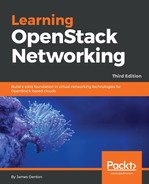Highly available routers can be created and managed using the same router command set discussed in the previous chapter. Neutron L3 agents are responsible for configuring the routers in a VRRP group, and the routers are left to elect a master router and implement their respective keepalived configuration based on their master or backup state at that time.
While HA routers provide a level of redundancy over their standalone counterparts, they are not without their drawbacks. A single node hosting a master router is still a bottleneck for traffic traversing that router. In addition, if the network used for dedicated VRRP traffic between routers experiences a loss of connectivity, the routers can become split-brained. This can cause two or more routers to become master routers and potentially cause ARP and MAC flapping issues in the network. Connection tracking between routers has not been implemented as of the Pike release, which means that connections to and from instances may be severed during a failover event. These shortcomings are being actively worked on and look to be addressed in future releases of OpenStack.
In the next chapter, we will look at how virtual routers can be distributed across compute nodes and serve as the gateway for their respective instances using a technology referred to as Distributed Virtual Routers, or DVR.
